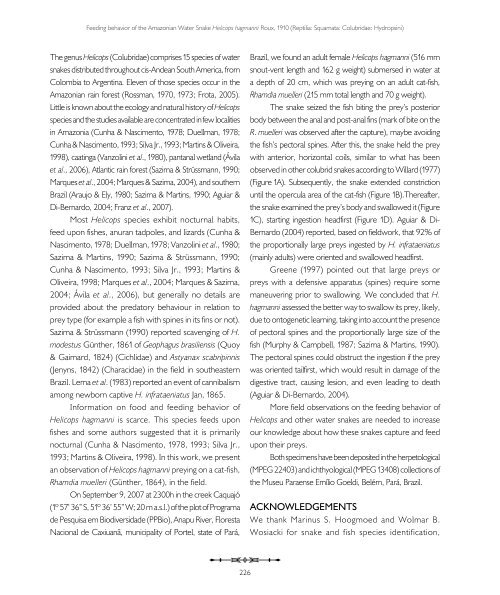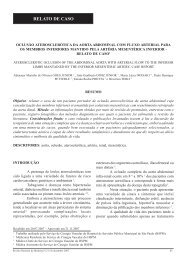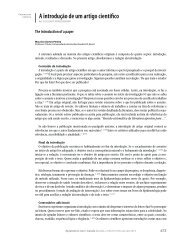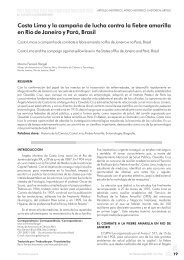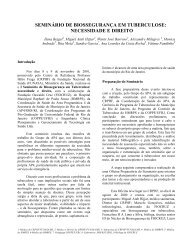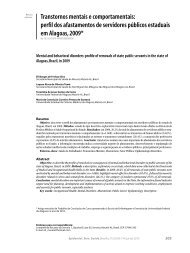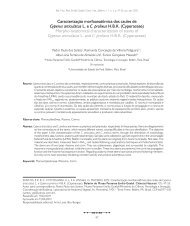Reptilia: Squamata: Colubridae: Hydropsini
Reptilia: Squamata: Colubridae: Hydropsini
Reptilia: Squamata: Colubridae: Hydropsini
Create successful ePaper yourself
Turn your PDF publications into a flip-book with our unique Google optimized e-Paper software.
Feeding behavior of the Amazonian Water Snake Helicops hagmanni Roux, 1910 (<strong>Reptilia</strong>: <strong>Squamata</strong>: <strong>Colubridae</strong>: <strong>Hydropsini</strong>)<br />
The genus Helicops (<strong>Colubridae</strong>) comprises 15 species of water<br />
snakes distributed throughout cis-Andean South America, from<br />
Colombia to Argentina. Eleven of those species occur in the<br />
Amazonian rain forest (Rossman, 1970, 1973; Frota, 2005).<br />
Little is known about the ecology and natural history of Helicops<br />
species and the studies available are concentrated in few localities<br />
in Amazonia (Cunha & Nascimento, 1978; Duellman, 1978;<br />
Cunha & Nascimento, 1993; Silva Jr., 1993; Martins & Oliveira,<br />
1998), caatinga (Vanzolini et al., 1980), pantanal wetland (Ávila<br />
et al., 2006), Atlantic rain forest (Sazima & Strüssmann, 1990;<br />
Marques et al., 2004; Marques & Sazima, 2004), and southern<br />
Brazil (Araujo & Ely, 1980; Sazima & Martins, 1990; Aguiar &<br />
Di-Bernardo, 2004; Franz et al., 2007).<br />
Most Helicops species exhibit nocturnal habits,<br />
feed upon fishes, anuran tadpoles, and lizards (Cunha &<br />
Nascimento, 1978; Duellman, 1978; Vanzolini et al., 1980;<br />
Sazima & Martins, 1990; Sazima & Strüssmann, 1990;<br />
Cunha & Nascimento, 1993; Silva Jr., 1993; Martins &<br />
Oliveira, 1998; Marques et al., 2004; Marques & Sazima,<br />
2004; Ávila et al., 2006), but generally no details are<br />
provided about the predatory behaviour in relation to<br />
prey type (for example a fish with spines in its fins or not).<br />
Sazima & Strüssmann (1990) reported scavenging of H.<br />
modestus Günther, 1861 of Geophagus brasiliensis (Quoy<br />
& Gaimard, 1824) (Cichlidae) and Astyanax scabripinnis<br />
(Jenyns, 1842) (Characidae) in the field in southeastern<br />
Brazil. Lema et al. (1983) reported an event of cannibalism<br />
among newborn captive H. infrataeniatus Jan, 1865.<br />
Information on food and feeding behavior of<br />
Helicops hagmanni is scarce. This species feeds upon<br />
fishes and some authors suggested that it is primarily<br />
nocturnal (Cunha & Nascimento, 1978, 1993; Silva Jr.,<br />
1993; Martins & Oliveira, 1998). In this work, we present<br />
an observation of Helicops hagmanni preying on a cat-fish,<br />
Rhamdia muelleri (Günther, 1864), in the field.<br />
On September 9, 2007 at 2300h in the creek Caquajó<br />
(1º 57’ 36” S, 51º 36’ 55” W; 20 m a.s.l.) of the plot of Programa<br />
de Pesquisa em Biodiversidade (PPBio), Anapu River, Floresta<br />
Nacional de Caxiuanã, municipality of Portel, state of Pará,<br />
Brazil, we found an adult female Helicops hagmanni (516 mm<br />
snout-vent length and 162 g weight) submersed in water at<br />
a depth of 20 cm, which was preying on an adult cat-fish,<br />
Rhamdia muelleri (215 mm total length and 70 g weight).<br />
The snake seized the fish biting the prey’s posterior<br />
body between the anal and post-anal fins (mark of bite on the<br />
R. muelleri was observed after the capture), maybe avoiding<br />
the fish’s pectoral spines. After this, the snake held the prey<br />
with anterior, horizontal coils, similar to what has been<br />
observed in other colubrid snakes according to Willard (1977)<br />
(Figure 1A). Subsequently, the snake extended constriction<br />
until the opercula area of the cat-fish (Figure 1B).Thereafter,<br />
the snake examined the prey’s body and swallowed it (Figure<br />
1C), starting ingestion headfirst (Figure 1D). Aguiar & Di-<br />
Bernardo (2004) reported, based on fieldwork, that 92% of<br />
the proportionally large preys ingested by H. infrataeniatus<br />
(mainly adults) were oriented and swallowed headfirst.<br />
Greene (1997) pointed out that large preys or<br />
preys with a defensive apparatus (spines) require some<br />
maneuvering prior to swallowing. We concluded that H.<br />
hagmanni assessed the better way to swallow its prey, likely,<br />
due to ontogenetic learning, taking into account the presence<br />
of pectoral spines and the proportionally large size of the<br />
fish (Murphy & Campbell, 1987; Sazima & Martins, 1990).<br />
The pectoral spines could obstruct the ingestion if the prey<br />
was oriented tailfirst, which would result in damage of the<br />
digestive tract, causing lesion, and even leading to death<br />
(Aguiar & Di-Bernardo, 2004).<br />
More field observations on the feeding behavior of<br />
Helicops and other water snakes are needed to increase<br />
our knowledge about how these snakes capture and feed<br />
upon their preys.<br />
Both specimens have been deposited in the herpetological<br />
(MPEG 22403) and ichthyological (MPEG 13408) collections of<br />
the Museu Paraense Emílio Goeldi, Belém, Pará, Brazil.<br />
ACKNOWLEDGEMENTS<br />
We thank Marinus S. Hoogmoed and Wolmar B.<br />
Wosiacki for snake and fish species identification,<br />
226


